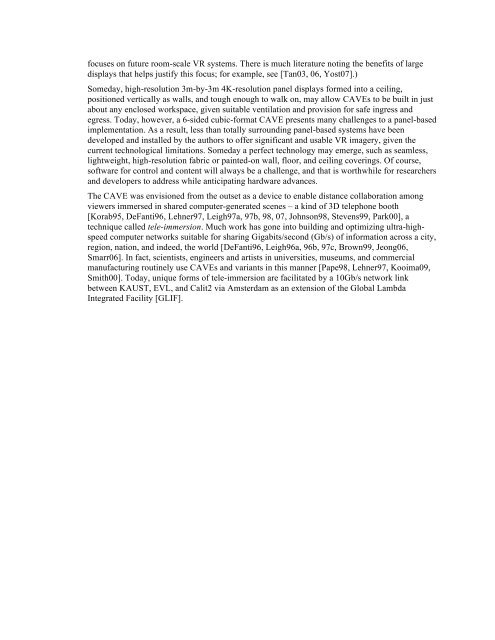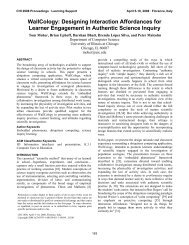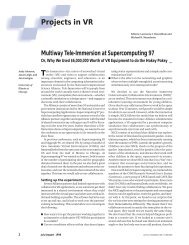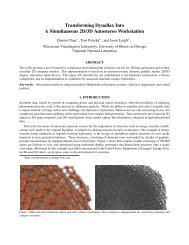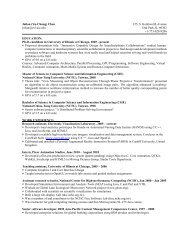The Future of the CAVE - Electronic Visualization Laboratory ...
The Future of the CAVE - Electronic Visualization Laboratory ...
The Future of the CAVE - Electronic Visualization Laboratory ...
You also want an ePaper? Increase the reach of your titles
YUMPU automatically turns print PDFs into web optimized ePapers that Google loves.
focuses on future room-scale VR systems. <strong>The</strong>re is much literature noting <strong>the</strong> benefits <strong>of</strong> large<br />
displays that helps justify this focus; for example, see [Tan03, 06, Yost07].)<br />
Someday, high-resolution 3m-by-3m 4K-resolution panel displays formed into a ceiling,<br />
positioned vertically as walls, and tough enough to walk on, may allow <strong>CAVE</strong>s to be built in just<br />
about any enclosed workspace, given suitable ventilation and provision for safe ingress and<br />
egress. Today, however, a 6-sided cubic-format <strong>CAVE</strong> presents many challenges to a panel-based<br />
implementation. As a result, less than totally surrounding panel-based systems have been<br />
developed and installed by <strong>the</strong> authors to <strong>of</strong>fer significant and usable VR imagery, given <strong>the</strong><br />
current technological limitations. Someday a perfect technology may emerge, such as seamless,<br />
lightweight, high-resolution fabric or painted-on wall, floor, and ceiling coverings. Of course,<br />
s<strong>of</strong>tware for control and content will always be a challenge, and that is worthwhile for researchers<br />
and developers to address while anticipating hardware advances.<br />
<strong>The</strong> <strong>CAVE</strong> was envisioned from <strong>the</strong> outset as a device to enable distance collaboration among<br />
viewers immersed in shared computer-generated scenes – a kind <strong>of</strong> 3D telephone booth<br />
[Korab95, DeFanti96, Lehner97, Leigh97a, 97b, 98, 07, Johnson98, Stevens99, Park00], a<br />
technique called tele-immersion. Much work has gone into building and optimizing ultra-highspeed<br />
computer networks suitable for sharing Gigabits/second (Gb/s) <strong>of</strong> information across a city,<br />
region, nation, and indeed, <strong>the</strong> world [DeFanti96, Leigh96a, 96b, 97c, Brown99, Jeong06,<br />
Smarr06]. In fact, scientists, engineers and artists in universities, museums, and commercial<br />
manufacturing routinely use <strong>CAVE</strong>s and variants in this manner [Pape98, Lehner97, Kooima09,<br />
Smith00]. Today, unique forms <strong>of</strong> tele-immersion are facilitated by a 10Gb/s network link<br />
between KAUST, EVL, and Calit2 via Amsterdam as an extension <strong>of</strong> <strong>the</strong> Global Lambda<br />
Integrated Facility [GLIF].


